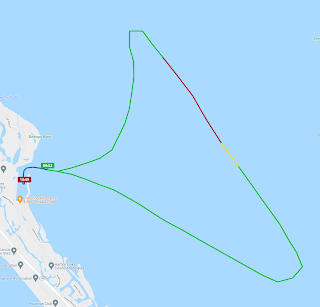First, props. After a river cruise like ours most everyone has had some kind of propellor issue. We are no exception. Between wallowing in mud, backing into logs, and hitting things we didn't see, we needed to have the props tended to when we got to Green Turtle Bay. At that time Russ thought the props looked really thin. The starboard prop had to be hammered flat. Moreover, we always had just a little vibration.
Additionally, we've never had them pitched, and we're certain the previous owner didn't either. It would make sense they were due, especially after the 2 years we've put on them.
 |
| Roseate Spoonbills. Love these birds. We see them occasionally on LBK. |
Russ and the engine guy had conversations about props and speed. Sure we could go faster if pitched differently but unless we could get the boat to plane we might as well be dumping fuel into the water, since we'd burn through it so quickly.
 |
| Sarasota, across the bay. |
Another engine topic was how many rpms could we do and for how long. The mechanic believed we could run the engines at 3400 rpm for hours. The Endeavour people thinks we could run them flat out for hours. After some chat it was clear we needed to know exactly what performance we were getting before we changed anything. We really had no clue how fast the boat would go with the throttles pegged and the engines wide open. That is something they checked on sea trial when we purchased the boat, and at that time she achieved 15 knots. But she had little or no water in the tank, little gas, and absolutely nothing on board like what we carry now (tools, spare parts, etc.) We were sure we were too heavy to get on plane but had no idea what our top speed would be.
 |
| Hey, I made Toad in the Hole. Those are vegan sausages, btw. |
There was a weather front coming in so we wanted to get this done before it hit. (Turns out it was nothing, but better safe, yadda yadda yadda). That meant, however, we were doing this at low tide, so clearance would be minimal -- the most we saw under the keel was 7 feet, and that was in the ICW channel. Shallow water can also impede performance; being so close to "land" you get a slight suction affect that drags. The path we decided to take was from south to north, which meant we were going against the tide and the wind. So, lots of forces acting against us.
We started slow out of our marina's channel, the sped up to our normal speed, 2300 rpms, which got us around 8 to 8.5 knots. Once we reached the ICW we turned northward (a very tight turn to get into the channel) and started stepping up our speeds. 2300 to 2600, then 3000, then 3200, then 3400. All the while I watched our course and speed while Russ watched the engine information, oil pressure and temperature. Everything was holding steady and, as we predicted, were traveling about 10.5 knots.
 |
| Not so much about Sarasota, altho it's very pretty in this picture. But the dots in the mangrove bush, just beyond the covered bike. Those are pelicans. They perch! |
Then I looked at our speed. Then I looked out of the window. We were absolutely flying. The nose had come down and this boat actually planed. We were just over 15 knots. Both of us were stunned.
We kept her in that state for 5 to 10 minutes, which was as long as we could before the channel turned. No overheating, no vibrations, no oil pressure issues, nothing! She ran beautifully.
Fully shocked and awed we turn back home and docked her.
It's not a bad idea to have a spare set of props ready, just in case. We can store them here should we need them. But for now we're no longer thinking we need to do anything with the props. We'll just wait and see how things go.
But this opens up a bunch of options for us. We might be able to cross the gulf the long way in the day. Or a quick trip to the keys. Or the Bahamas...

No comments:
Post a Comment